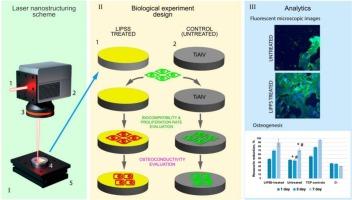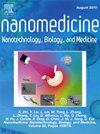通过激光诱导对钛植入物进行表面改性,增强成骨细胞的骨整合和成骨作用。
IF 4.2
2区 医学
Q2 MEDICINE, RESEARCH & EXPERIMENTAL
Nanomedicine : nanotechnology, biology, and medicine
Pub Date : 2024-09-20
DOI:10.1016/j.nano.2024.102785
引用次数: 0
摘要
牙科和骨科植入物已成为牙齿替换和骨固定的常规医疗技术。尽管种植学取得了重大进展,但实现充分的骨结合仍然是一项挑战,往往会导致种植体长期失效。纳米技术具有模仿活组织自然形态的潜力,为组织工程和种植体表面设计提供了一个前景广阔的平台。在开发纳米结构的各种方法中,高规则激光诱导周期表面结构(HR-LIPSS)技术因其能够制造出高度有序的纳米结构、出色的长程可重复性和生产效率而脱颖而出。在这项研究中,我们采用了一种创新的技术方法来生成传统的激光诱导表层 LIPSS 纳米结构,然后使用经典的显微镜和物理化学方法进行了详细的表面分析。我们的研究结果首次证明,LIPSS 纳米结构表面能显著增强细胞粘附和增殖,同时为细胞代谢提供最佳环境。鉴于 HR-LIPSS 技术的高可重复性、低成本和支持细胞生长和分化的潜力,这项新技术有可能对新型植入物的工业开发和植入后的临床效果产生影响。本文章由计算机程序翻译,如有差异,请以英文原文为准。

Enhanced osteointegration and osteogenesis of osteoblast cells by laser-induced surface modification of Ti implants
Dental and orthopedic implants have become routine medical technologies for tooth replacement and bone fixation. Despite significant progress in implantology, achieving sufficient osseointegration remains a challenge, often leading to implant failure over the long term. Nanotechnology offers the potential to mimic the natural patterns of living tissues, providing a promising platform for tissue engineering and implant surface design. Among the various methods for developing nanostructures, High-Regular Laser-Induced Periodic Surface Structures (HR-LIPSS) techniques stand out for their ability to fabricate highly ordered nanostructures with excellent long-range repeatability and production efficiency. In this study, we utilized an innovative technical approach to generate traditional laser-induced superficial LIPSS nanostructures, followed by detailed surface analysis using classical microscopy and physicochemical methods. Our findings demonstrate for the first time that nanostructured LIPSS surfaces can significantly enhance cell adhesion and proliferation while providing an optimal environment for cell metabolism. Given the high reproducibility, low cost, and potential of HR-LIPSS techniques to support cell growth and differentiation, this novel technology has the potential to impact both the industrial development of new implants and clinical outcomes after implantation.
求助全文
通过发布文献求助,成功后即可免费获取论文全文。
去求助
来源期刊
CiteScore
11.10
自引率
0.00%
发文量
133
审稿时长
42 days
期刊介绍:
The mission of Nanomedicine: Nanotechnology, Biology, and Medicine (Nanomedicine: NBM) is to promote the emerging interdisciplinary field of nanomedicine.
Nanomedicine: NBM is an international, peer-reviewed journal presenting novel, significant, and interdisciplinary theoretical and experimental results related to nanoscience and nanotechnology in the life and health sciences. Content includes basic, translational, and clinical research addressing diagnosis, treatment, monitoring, prediction, and prevention of diseases.

 求助内容:
求助内容: 应助结果提醒方式:
应助结果提醒方式:


